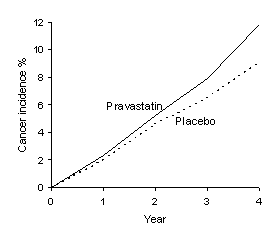|
This
is a contribution from a member of THINCS,
The International Network of Cholesterol Skeptics
 Home
Home
Letter to the editor of Lancet, sent 10. December
2002
Evidence that statin
treatment causes cancer
Although the benefit of 22 fewer deaths
from vascular disease was neutralised by 24 more deaths from cancer, the
directors of the new statin trial PROSPER1 recommend
pravastatin also for old people. They belittle the increased
incidence of cancer by referring to their meta-analysis of all clinical
statin trials according to which they found no overall increase in cancer.
However, in that
analysis non-melanoma skin cancer was excluded. Chemical carcinogenesis in
human beings is a process that demands many years. If statin treatment
promotes all types of cancer in human beings, as it seems to do in
experimental animals,2 we should expect that the first ones to
be seen were those that are easily detectable, the superficial ones, and
we should also expect to see cancer primarily in old people, because the
strongest risk factor for cancer is age. This is also what has happened.
An increased incidence of non-melanoma skin cancer was observed in the
simvastatin trials, 4S3 and HPS4 (no figures were
given in the other trials). The difference between treatment and control
group was not statistically significant in either of them, but it became
significant if calculated together (simvastatin groups 256/12490, control
groups 218/12490; p=0.028). In the CARE trial5 breast cancer,
another readily detectable malignancy was seen in 12 women in the
treatment group but in only one of the control individuals, a highly
significant difference. The significant increase of cancer in people age
70-82 (PROSPER) is a further warning that cannot be dismissed by referring
to trials where the mean age was much lower.
 Figure.
Cancer incidence after cholesterol-lowering treatment of elderly
individuals at risk of vascular disease. The incidence of skin cancer was
not reported. The diagram is constructed using the data from the trial
report. The difference between cancer incidences at year four was
statistically significant (hazard ratio 1.25; CI 1.04-1.51). (This figure
was not included in the letter to Lancet) Figure.
Cancer incidence after cholesterol-lowering treatment of elderly
individuals at risk of vascular disease. The incidence of skin cancer was
not reported. The diagram is constructed using the data from the trial
report. The difference between cancer incidences at year four was
statistically significant (hazard ratio 1.25; CI 1.04-1.51). (This figure
was not included in the letter to Lancet)
Uffe Ravnskov, MD, PhD, independent
researcher,
Magle Stora Kyrkogata
9, S-22350 Lund, Sweden
- Shepherd J, Blauw GJ, Murphy MB, et al. Pravastatin in elderly
individuals at risk of vascular disease (PROSPER): a randomised
controlled trial. Lancet 2002; 360: 1623-30.
- Newman TB, Hulley SB. Carcinogenicity of lipid-lowering drugs. JAMA 1996; 275: 55-60.
- Randomised trial of cholesterol lowering in 4444 patients with
coronary heart disease: the Scandinavian Simvastatin Survival Study
(4S). Lancet 1994;
344:1383-9.
- Heart Protection Study Collaborative Group. MRC/BHF heart
protection study of cholesterol lowering in 20 536 high-risk
individuals: a randomised placebo-controlled trial. Lancet 2002; 360: 7-22.
- Sacks FM, Pfeffer MA, Moye LA, et al.
for the Cholesterol and Recurrent Events Trial investigators. The effect
of pravastatin on coronary events after myocardial infarction in
patients with average cholesterol levels. N Engl J Med 1996; 335:
1001-9.
Editors answer:
20. December 2002
Dear Dr Ravnskov
Thank you for your communication on Evidence
that statin treatment causes cancer, which you sent for publication in
our Correspondence columns. I´m afraid we have decided not to accept your
letter for publication on this occasion. Well over 3000 letters are
submitted every year, and our criteria for acceptance are therefore very
stringent. I wish you luck with acceptance in another forum.Yours
sincerely
Zoë
Mullan
Senior
Editor
 Read
also the published responses to PROSPER
Read
also the published responses to PROSPER
 Home
Home
|